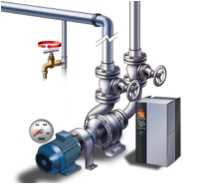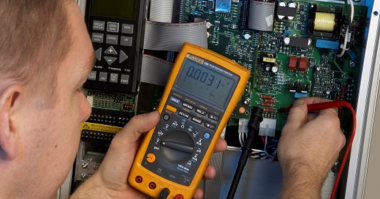There is a lot of discussion in the pumping industry about the reliability of sensorless pump control. While controlling pumps through indirect measurements has been available to the market for many years in a variable frequency drives, it has largely been very innovative companies, who have adopted this. A lot of the discussion is centred on the accuracy of the indirect method and claims are made that it does not work properly.
While the accuracy of a high quality pressure transducer or flow meter is naturally better. These types of control however uses pump manufacturer data to correlate the power consumption and speed of the pump to the pressure and flow points of the pump and with accurate data there is a very good accuracy also with the indirect control. The variance in the available pump data and the accuracy of the original data is off course extremely important and since data sheet values represent average data for any specific pump type; these may not provide sufficient accuracy. In most cases however the controls implemented are using the data measured for the specific pump in a factory controlled test environment.
An entirely different question is how much accuracy really matters in any given application. Especially in HVAC and Water applications the control accuracy requirement is not nearly as high as in some industrial applications. Before making a choice to implement sensorless pump control it is therefore important to first understand the application.
Life Cycle Cost or Ideal Measurement
There is no discussion that a transducer will provide a more accurate measurement than any indirect means of measuring. The real question is how the accuracy impacts the optimum operation of the system and what the added value (increased cost) is worth in the individual installation.
Using the VFD as an indirect measurement will reduce the installation cost, not only due to the reduced component cost, but also because of the reduced complexity of the installation. Often the pump will come with the drive pre-installed to the motor and with all settings prepared by the pump manufacturer, saving significant time on site. If the VFD is factory installed and calibrated, then it is almost only a matter of connecting the pipes and the mains wire to get the pump up and running.
Also with factory pre-configured systems, the cost and time for trouble shooting is reduced tremendously, since all the wiring and programming has already been done at the pump manufacturer’s facility.
A properly calibrated sensorless control, applied to a pump suited for this type of control, will typically have a control accuracy of less than ±5%. If we compare this to how typical HVAC and Water systems are designed and dimensioned, then a multitude of safety factors and mechanical inaccuracies apply, making the design prone to deviations from the assumed optimum operating point.
Default system setpoint is really just an operating point, where it is assumed that the system will most likely operate properly. The actual optimum setpoint will likely be lower, but determining this is impossible before installation, as the specific system losses are not known until the actual components are combined. To achieve optimum operation the system should be tested to determine actual critical point in the system and a pressure transducer should be installed to monitor that point. This is however often not practical, so most transducers are placed near the pump and system losses are compensated in the controller, known as dynamic flow compensation. This means that even with sensors in the system, the critical point is controlled based on assumptions about system performance. Also most installations are not trimmed to the optimum performance if the settings provided to the contractor result in satisfactory operation for the users of the system.
An accuracy of ±5% would mean that the actual setpoint, if set at 5 bar, in a sensorless system, would range from 4.75 to 5.25 bar. This would certainly not result in any system critical over pressure and would likely also secure good operation of the system based on the above assumptions. If the system is not working satisfactory, then it would be a simple matter of trimming the controls to the operation conditions.
Pump Selection
The highest number of failed sensorless installations is found when the pump selection is not taking the limitations of the control method into consideration. In most cases a simple investigation of the pump curve will tell if the pump is suited for sensorless pump control.
 Some pumps have a very flat pump curve and as such sensorless pump control will have very limited variance to calculate the load point. When the accuracy of the VFD components is then also taken into account, the probability of increasing inaccuracy is very high. In some cases, I have seen up to ±40% deviation between calculation and measurement. It is necessary that there is a suitable correlation between the change in pressure/flow and the power consumption/speed of the motor. The examples in this link, show this very well. A radial flow pump has a clear correlation between head, flow and shaft power, where as a mixed flow pump has almost flat correlation and it will be almost impossible to determine from the power reading where you are on the pump curve.
Some pumps have a very flat pump curve and as such sensorless pump control will have very limited variance to calculate the load point. When the accuracy of the VFD components is then also taken into account, the probability of increasing inaccuracy is very high. In some cases, I have seen up to ±40% deviation between calculation and measurement. It is necessary that there is a suitable correlation between the change in pressure/flow and the power consumption/speed of the motor. The examples in this link, show this very well. A radial flow pump has a clear correlation between head, flow and shaft power, where as a mixed flow pump has almost flat correlation and it will be almost impossible to determine from the power reading where you are on the pump curve.
Because of this, it is highly recommended to implement sensorless pump control in a close cooperation with the pump manufacturer and ask that the performance is verified on the pump type in question. Achieving good accuracy with field applied sensorless pump control can be very difficult, as there can be unexpected influences on the operating conditions, which impact the calibration of the system.
It is also recommended to validate the performance if a pump overhaul is conducted as this may change the power vs pressure/flow correlation slightly, thus impacting the control accuracy.
Another reason for too high inaccuracies is that the motor will also impact the load data measured by the VFD. If another motor is used than then one used to generate the sensorless data, this will impact the resulting pressure and flow calculated, so the correlation between the applied motor and the motor used to generate the data for sensorless pump control, needs to be determined, if another motor is used. Such data is never represented in publically available material. Measuring two data points should however be sufficient to offset the data to the selected motor, with limited impact to control accuracy.
Other Application Considerations
Sensorless pump control should only be applied to non-compressible liquids, as only in this case will there be a constant power vs. pressure/flow relationship.
Pump manufacturers mostly use clean water to calibrate the sensorless control, so if other liquids are used, it should be checked with the manufacturer of the pump if there is a requirement for recalibration, when other liquids are applied.
For wastewater systems it is never recommended to use sensorless pump control. This is simply because there is no fixed correlation between flow and power. Depending on the amount of solid in the water power at any given operating point will vary significantly, making sensorless control impossible.
Though considered clean water pumps, there are in some locations similar consideration for raw water pumps, including deepwell pumps, as the water may contain solids.
Conclusion
There is a wide range of applications, where sensorless pump control can be successfully applied, but it is important that the technical limitations of indirect measurements are taken into consideration.
It is also extremely important to consider the application requirements in terms of control accuracy. If a high accuracy is required, then it is most likely better to use a high grade transducer for the control. Most HVAC/R and water applications can however use sensorless pump control without any significant impact on performance.
Working closely with the manufacturers of the pump and variable frequency drives, is the best way to avoid some of the pitfalls related to sensorless pump control and secure a successful implementation. Mostly the pump manufacturer will be able to provide a package with pump, motor and drive, which are fully tested and have all required data loaded to the drive from the factory, thus providing a factory supported solution to the installation.





Great information. Article helps to better understand the sensor less pump technology.
Hi Alexander,
glad to know the information helps. Feedback is greatly appreciated.
Br Frank
[…] Article by: Frank Taaning-Grundholm This article was also published on Empowering Pumps […]